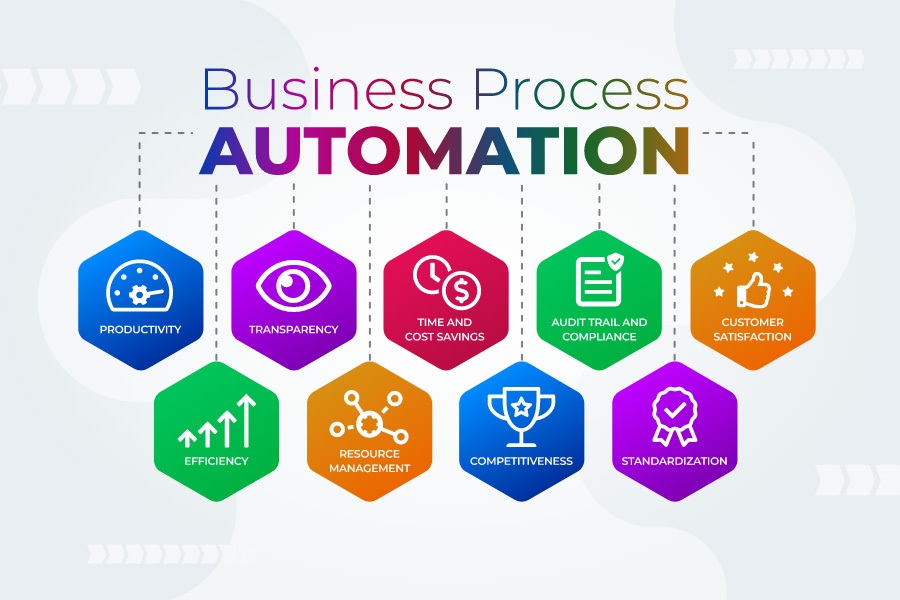
Automating Early Business Processes for Efficiency: Your Startup’s Secret Weapon
Starting a new business is an exciting adventure, but it often comes with a hefty dose of "wearing many hats." As a founder or early team member, you’re probably juggling sales, marketing, customer service, finance, and product development all at once. This can quickly become overwhelming, leading to burnout, missed opportunities, and slower growth.
The good news? You don’t have to do everything manually. In today’s digital age, even the smallest businesses can leverage automation to streamline operations, save precious time, reduce costs, and set themselves up for scalable success right from the get-go. This comprehensive guide will walk you through the why, what, and how of automating early business processes for efficiency, making it easy for even beginners to understand.
Why Automate Your Business Processes Early? It’s Not Just for Big Companies!
Many new entrepreneurs believe automation is a luxury reserved for large corporations with huge budgets. This couldn’t be further from the truth! In fact, the earlier you embrace automation, the greater the long-term benefits for your small business or startup.
Here’s why automating early business processes is a strategic move:
- Massive Time Savings:
- Think about repetitive tasks: sending follow-up emails, scheduling appointments, categorizing expenses, posting on social media, or entering customer data. These small, frequent tasks add up to hours each week.
- Automation frees up this time, allowing you to focus on high-value activities like strategizing, innovating, building relationships, and growing your core business.
- Significant Cost Reduction (Long-Term):
- While there might be an initial investment in tools, automation drastically reduces the need for manual labor as you scale. You can achieve more with a smaller team, delaying or even eliminating the need to hire additional staff for administrative roles.
- It also minimizes errors, which can be costly to fix (e.g., incorrect invoices, missed payments).
- Reduced Errors and Improved Accuracy:
- Humans make mistakes, especially when tired or dealing with large volumes of data. Automation tools follow predefined rules consistently, virtually eliminating human error in data entry, calculations, and repetitive communications.
- This leads to more reliable data, better decision-making, and a more professional image.
- Enhanced Scalability and Growth:
- Imagine if every new customer meant doubling your manual workload. That’s a recipe for hitting a growth ceiling.
- Automated processes are designed to handle increased volume without a proportional increase in effort. As your business grows, your automated systems can easily keep up, allowing for smooth, rapid expansion.
- Better Customer Experience:
- Automated responses, quick scheduling, and consistent follow-ups create a seamless and professional experience for your customers.
- Customers appreciate prompt communication and efficient service, which builds trust and loyalty.
- Focus on Core Business and Innovation:
- By offloading mundane tasks, you and your team can dedicate more energy to what truly matters: developing great products or services, fostering customer relationships, and devising new strategies for growth.
- This fosters creativity and allows you to stay competitive.
Key Areas for Early Business Process Automation
So, where should you start? While almost any repetitive task can be automated, some areas offer the biggest bang for your buck in early-stage businesses.
1. Marketing & Sales Automation
- Email Marketing:
- What to automate: Sending welcome emails to new subscribers, drip campaigns (a series of pre-written emails sent over time) to nurture leads, follow-ups after a demo or download, birthday messages.
- Benefits: Consistent communication, lead nurturing on autopilot, segmentation of audiences for targeted messages.
- Tools: Mailchimp, ConvertKit, HubSpot (free CRM and marketing tools), ActiveCampaign.
- Customer Relationship Management (CRM):
- What to automate: Logging interactions with leads and customers, setting reminders for follow-ups, tracking sales pipelines, sending automated meeting confirmations.
- Benefits: Centralized customer data, never miss a follow-up, improved sales efficiency.
- Tools: HubSpot CRM (free), Zoho CRM, Salesforce Essentials, Pipedrive.
- Social Media Scheduling:
- What to automate: Scheduling posts to go live at optimal times across various platforms (Facebook, Instagram, LinkedIn, Twitter).
- Benefits: Consistent online presence, saves time daily, reaches wider audiences.
- Tools: Buffer, Hootsuite, Sprout Social.
2. Customer Service & Communication Automation
- FAQs & Knowledge Bases:
- What to automate: Providing instant answers to common questions without direct human intervention.
- Benefits: Reduces customer support volume, empowers customers to find solutions, 24/7 support.
- Tools: Zendesk, Freshdesk, dedicated FAQ sections on your website.
- Chatbots:
- What to automate: Handling basic inquiries on your website, directing customers to relevant information, collecting contact details for follow-up.
- Benefits: Immediate responses, lead qualification, always available.
- Tools: Many website builders (e.g., Shopify, WordPress) have chatbot integrations; Tidio, Intercom.
- Ticket Management:
- What to automate: Auto-assigning support requests to the right team member, sending automated "we received your request" notifications.
- Benefits: Organized support, faster resolution times, clear accountability.
- Tools: Zendesk, Freshdesk, HubSpot Service Hub.
3. Finance & Accounting Automation
- Invoicing & Payment Reminders:
- What to automate: Generating and sending invoices, setting up automatic payment reminders for overdue bills.
- Benefits: Faster payments, reduced administrative burden, improved cash flow.
- Tools: QuickBooks Online, Xero, FreshBooks, Wave (free).
- Expense Tracking & Receipt Management:
- What to automate: Capturing receipts (often via a photo), categorizing expenses, syncing with accounting software.
- Benefits: Accurate financial records, simplified tax preparation, real-time spending insights.
- Tools: Expensify, Receipt Bank (Dext), QuickBooks Online, Xero.
- Payroll (as you grow):
- What to automate: Calculating wages, taxes, and deductions; direct deposits; generating pay stubs.
- Benefits: Ensures compliance, accurate and timely payments, saves significant HR time.
- Tools: Gusto, ADP Run, Paychex.
4. Project Management & Internal Communication
- Task Management & Workflow Automation:
- What to automate: Assigning tasks based on triggers (e.g., new project created), sending notifications for deadlines, moving tasks through stages (e.g., "To Do" to "In Progress" to "Done").
- Benefits: Improved team collaboration, clear responsibilities, better project visibility, fewer missed deadlines.
- Tools: Asana, Trello, Monday.com, ClickUp, Notion.
- Meeting Scheduling:
- What to automate: Allowing clients or team members to book available slots directly from your calendar without back-and-forth emails.
- Benefits: Saves significant time in coordination, reduces scheduling conflicts.
- Tools: Calendly, Acuity Scheduling, SavvyCal.
5. HR & Onboarding (Basic)
- New Hire Forms & Onboarding Checklists:
- What to automate: Sending digital onboarding documents, sharing welcome materials, tracking completion of necessary paperwork.
- Benefits: Professional first impression for new hires, ensures compliance, reduces manual paperwork.
- Tools: HRIS (Human Resources Information Systems) like BambooHR (for more established small businesses), or simpler tools like Typeform/Google Forms integrated with task managers.
How to Get Started with Automating Your Business Processes (A Beginner’s Guide)
Feeling a bit overwhelmed by all the options? Don’t be! The key is to start small and iterate. Here’s a simple step-by-step approach:
Step 1: Identify Your Pain Points & Repetitive Tasks
- List everything you do regularly. For one week, keep a log of every task you perform, noting how long it takes and how often you do it.
- Look for patterns. Which tasks are highly repetitive? Which ones take up a lot of time but don’t require complex decision-making?
- Ask your team (if you have one). What frustrates them? What administrative tasks do they dread?
- Prioritize. Focus on tasks that are:
- Frequent: Done daily or multiple times a week.
- Time-consuming: Take more than a few minutes each time.
- Error-prone: Where mistakes often occur.
- Mind-numbing: Tasks that drain your energy and prevent you from doing more important work.
Example: "I spend 2 hours every Monday manually sending follow-up emails to new website leads." This is a perfect candidate!
Step 2: Research & Choose the Right Tools (Start Simple!)
- Don’t overcomplicate it. For early automation, focus on "SaaS" (Software as a Service) tools that are cloud-based, easy to set up, and often have free or low-cost basic plans.
- Look for "No-Code" or "Low-Code" solutions. These tools are designed for non-programmers, allowing you to build automated workflows with drag-and-drop interfaces.
- Read reviews. Check out sites like G2, Capterra, or Software Advice to compare tools and read user experiences.
- Consider integrations. Can the tools you choose "talk" to each other? For example, can your email marketing tool integrate with your CRM? Tools like Zapier or Make (formerly Integromat) are fantastic for connecting different apps.
- Start with one or two key areas. Don’t try to automate everything at once. Pick the biggest pain point and tackle that first.
Step 3: Implement, Test, and Iterate
- Set up the automation. Follow the tool’s instructions. Most modern tools have excellent onboarding guides and tutorials.
- Test thoroughly. Before going live, run several tests to ensure the automation works exactly as intended. Send test emails, create test tasks, submit test forms.
- Gather feedback. If it affects your team or customers, ask for their input. Is it making their lives easier or harder?
- Adjust as needed. Automation isn’t a "set it and forget it" process. As your business evolves, your automated workflows might need tweaking or expanding.
Step 4: Train Your Team (If Applicable)
- Communicate the "Why": Explain why you’re implementing automation – to save time, reduce errors, and help the business grow, ultimately making everyone’s job easier and more fulfilling.
- Provide clear instructions: Don’t just implement a new tool and expect everyone to figure it out. Offer training sessions, create simple guides, or record short video tutorials.
- Encourage adoption: Lead by example. Show how the new processes benefit them personally.
Step 5: Monitor & Optimize
- Track your results. Are you actually saving time? Are errors decreasing? Is customer satisfaction improving? Most automation tools provide analytics.
- Look for new opportunities. Once you’ve successfully automated one process, you’ll start to see other areas where automation could make a difference.
- Stay updated. Technology evolves rapidly. Keep an eye on new tools and features that could further enhance your efficiency.
Common Myths About Early Business Automation
Let’s bust some common misconceptions that might be holding you back:
- Myth 1: "It’s too expensive for a small business."
- Reality: Many powerful automation tools offer free tiers or very affordable monthly subscriptions designed for startups. The ROI (Return on Investment) in terms of saved time and reduced errors usually far outweighs the cost.
- Myth 2: "It’s too complicated to set up."
- Reality: Modern tools are incredibly user-friendly, with intuitive interfaces and drag-and-drop functionality. You don’t need to be a tech guru or coder.
- Myth 3: "Automation will replace human jobs."
- Reality: For early businesses, automation empowers your small team. It takes away the tedious, repetitive work, allowing your valuable employees to focus on creative problem-solving, strategic thinking, and building genuine human connections with customers – tasks that only humans can do well. It helps you do more with less, not replace your people.
- Myth 4: "My business isn’t big enough for automation."
- Reality: This is precisely why you should automate early! It lays a strong foundation for growth, preventing bottlenecks and inefficiencies before they become major problems. It helps you act like a bigger, more established company from day one.
Future-Proofing Your Business with Automation
By proactively automating early business processes, you’re not just solving today’s problems; you’re investing in your business’s future. You’re building a resilient, efficient, and scalable operation that can adapt to challenges and seize opportunities.
Imagine a future where:
- New leads are automatically qualified and nurtured.
- Customer queries are resolved instantly or routed efficiently.
- Invoices are sent and reconciled without manual intervention.
- Your team spends their days on innovation, not administration.
This future is achievable, even for the leanest of startups. Embrace the power of automation, start small, and watch your business thrive. It’s not just about doing things faster; it’s about doing the right things, more effectively, and setting yourself up for sustainable success.



Post Comment